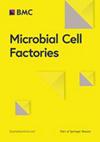Photosynthesizing carbonate/nitrate into Chlorococcum humicola biomass for biodiesel and Bacillus coagulans-based biohydrogen production
IF 4.3
2区 生物学
Q1 BIOTECHNOLOGY & APPLIED MICROBIOLOGY
引用次数: 0
Abstract
Biofuel can be generated by different organisms using various substrates. The green alga Chlorococcum humicola OQ934050 exhibited the capability to photosynthesize carbonate carbon, maybe via the activity of carbonic anhydrase enzymes. The optimum treatment is C:N ratio of 1:1 (0.2 mmoles sodium carbonate and 0.2 mmoles sodium nitrate) as it induced the highest dry mass (more than 0.5 mg.mL−1). At this combination, biomass were about 0.2 mg/mL−1 carbohydrates, 0.085 mg/mL−1 proteins, and 0.16 mg/mL−1 oil of this dry weight. The C/N ratios of 1:1 or 10:1 induced up to 30% of the Chlorococcum humicola dry mass as oils. Growth and dry matter content were hindered at 50:1 C/N and oil content was reduced as a result. The fatty acid profile was strongly altered by the applied C.N ratios. The defatted leftovers of the grown alga, after oil extraction, were fermented by a newly isolated heterotrophic bacterium, identified as Bacillus coagulans OQ053202, to evolve hydrogen content as gas. The highest cumulative hydrogen production and reducing sugar (70 ml H2/g biomass and 0.128 mg/ml; respectively) were found at the C/N ratio of 10:1 with the highest hydrogen evolution efficiency (HEE) of 22.8 ml H2/ mg reducing sugar. The optimum treatment applied to the Chlorococcum humicola is C:N ratio of 1:1 for the highest dry mass, up to 30% dry mass as oils. Some fatty acids were induced while others disappeared, depending on the C/N ratios. The highest cumulative hydrogen production and reducing sugar were found at the C/N ratio of 10:1.光合作用将碳酸盐/硝酸盐转化为腐生绿球藻生物质,用于生产生物柴油和凝结芽孢杆菌生物氢
生物燃料可由不同生物利用各种底物生成。绿藻 Chlorococcum humicola OQ934050 表现出光合作用碳酸盐碳的能力,这可能是通过碳酸酐酶的活性实现的。最佳处理是碳氮比为 1:1(0.2 毫摩尔碳酸钠和 0.2 毫摩尔硝酸钠),因为它能产生最高的干质量(超过 0.5 毫克/毫升-1)。在这种组合下,生物量约为 0.2 毫克/毫升-1 碳水化合物、0.085 毫克/毫升-1 蛋白质和 0.16 毫克/毫升-1 油。1:1或10:1的C/N比可诱导出高达30%的腐叶绿藻干物质为油。C/N 比为 50:1 时,生长和干物质含量受阻,油含量也随之减少。所采用的 C/N 比严重改变了脂肪酸组成。榨油后的藻类脱脂残渣由一种新分离出来的异养菌(确定为凝结芽孢杆菌 OQ053202)发酵,以气体形式产生氢气。在 C/N 比为 10:1 时,累积产氢量和还原糖最高(分别为 70 毫升 H2/g 生物质和 0.128 毫克/毫升),氢进化效率(HEE)最高,为 22.8 毫升 H2/ 毫克还原糖。对腐生绿球藻的最佳处理方法是 C:N 比为 1:1,以获得最高的干物质,油的干物质含量可达 30%。根据 C/N 比率的不同,一些脂肪酸被诱导产生,而另一些则消失了。C/N比为10:1时,累积产氢量和还原糖最高。
本文章由计算机程序翻译,如有差异,请以英文原文为准。
求助全文
约1分钟内获得全文
求助全文
来源期刊

Microbial Cell Factories
工程技术-生物工程与应用微生物
CiteScore
9.30
自引率
4.70%
发文量
235
审稿时长
2.3 months
期刊介绍:
Microbial Cell Factories is an open access peer-reviewed journal that covers any topic related to the development, use and investigation of microbial cells as producers of recombinant proteins and natural products, or as catalyzers of biological transformations of industrial interest. Microbial Cell Factories is the world leading, primary research journal fully focusing on Applied Microbiology.
The journal is divided into the following editorial sections:
-Metabolic engineering
-Synthetic biology
-Whole-cell biocatalysis
-Microbial regulations
-Recombinant protein production/bioprocessing
-Production of natural compounds
-Systems biology of cell factories
-Microbial production processes
-Cell-free systems
 求助内容:
求助内容: 应助结果提醒方式:
应助结果提醒方式:


